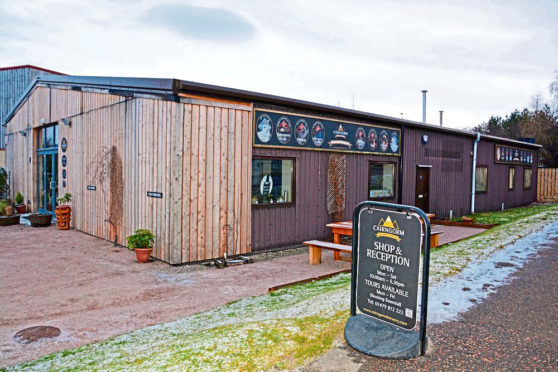Soaking up the summer sunshine outside a pub, it’s easy to forget all the effort that’s gone into producing a glass of beer.
Growing the barley, fermenting the brew, transporting the beer – producing the perfect pint, half or schooner is full of complex procedures.
Yet one stage in the process seems to have caused more of a headache than others for brewers over the years. Again and again, beer producers have talked about their difficulties when it comes to bottling their wares.
That challenge was eased for brewers in the north of Scotland back in 2012, when Cairngorm Brewery in Aviemore opened its bottling line, which had space not only to package its own beers but also to undertdake contract work for other producers too.
The bottling line was part of Cairngorm’s £1.6 million expansion and was financed with a £660,000 loan from Bank of Scotland, grants of £150,000 and £100,000 from Highlands and Islands Enterprise and the European Regional Development Fund and funds from shareholder Martin Riley.
Fourteen breweries have used the company’s bottling services, boosting the industry in the north and giving more entrepreneurs the chance to set up their own businesses.
Without having such a centrally-located bottling line, brewers would have to send their beer south in tankers; while Cairngorm can bottle batches of beer as small as 1,000 litres, tankers need to carry 20,000 litres, meaning it could take a micro-brewery up to a month to produce enough beer to fill a load, making the process impractical for some.
Yet time marches on and one trend more than any other feels like it’s dominated the beer sector over the intervening six years – the rise of the “craft can”. Ripping the ring-pull off a “tinnie” is nothing new and the metal can has been the mainstay of the mainstream beer market for generations.
While the origins of the craft beer movement came through cask-conditioned ales – whether in barrels or bottles – drunk by men with hairy beards and even hairier jumpers, a new wave of microbreweries has followed the trend from America for putting highly-hopped beers in kegs and cans, emphasising their freshness.
These brews, often favoured by moustache-wielding tattooed hipsters, are gaining more and more shelf space in both off licences and supermarkets.
One of the early adopters was the all-conquering BrewDog, which began putting its Punk India pale ale (IPA) into cans in 2011. Now based in Ellon but at the time still located in Fraserburgh, the Scottish company sent its IPA down to Daniel Thwaites’ brewery in England to be canned.
BrewDog had asked its fans to vote for which beer they wanted to be put into the new packaging. It has since extended cans across its range, from Dead Pony Club and Elvis Juice through to Jack Hammer and its low-alcohol Nanny State.
Never one to shy away from a controversial marketing stunt, the company also released “the strongest canned ale in the world” in October 2015 with the 12.7% alcohol-by-volume (ABV) Black-Eye King Imp, a Russian imperial stout. Demand for cans had proved so high that, six months earlier, BrewDog had installed its own canning line alongside its bottling apparatus.
A quarter of all the craft beer produced in the UK is now sold in cans, with the latest figures from market research firm Nielson showing that sales of craft cans rose by 66% during the first half of the year, compared with a 3% dip in bottled ale sales. Demand for beer with a full metal jacket shows no sign of abating.
“Cans are a great choice for drinks brands, retailers and consumers alike,” suggests Marcel Arsand, chairman of industry body Can Makers, which points out younger customers are drawn to the “bold, vibrant 360-degree designs that have become synonymous with craft beer” on cans. Brewers like cans as “they are easy to transport and protect the beverage from light, ensuring the drink they are so passionate about tastes the same when consumed as it does when brewed”.
“We expect to continue to see greater interest in drink cans pack format after witnessing the success craft beer in cans has enjoyed,” adds Arsand. He highlights that, according to Nielsen, there have also been early indications of increased interest in craft cider, following the success of canned craft beer.
“Not only are cans convenient and easy to chill, they are also infinitely recyclable,” he says. “This means that consumers can enjoy their favourite drink in a packaging that can be back on the shelf as another drinks can in as little as eight weeks.”
The perceived environmental benefits certainly strike a chord with Seb Jones, the chemistry student-turned-brewer who founded Forres-based Speyside Brewery in 2012. “Cans are better for the environment,” he agrees.
“With all the different formats available now, we have specific customers asking for specific vessels.”
Yet there’s also a strong business case for canning. The containers could also have an important role to play in economic development in rural areas.
“We now need a canning line, rather than another bottling line in Scotland,” says Jones. “My vote’s with canning.
“For the industry up here, Cairngorm is a really important part of that puzzle. Cairngorm is perfectly situated between the Central Belt and the Highlands, so if we can get a canning line somewhere in the middle of Scotland then that would definitely benefit the industry.
“Canning comes into its own when you’re exporting or sending pallets down south because basically you can fit double the volume of beer on the same weight of pallet. For anyone sending beer away, if we can get it in cans then that means we can get double the volume on the same unit.
“If we could have access to canning up here then that could open up markets for exports, and down south.”
